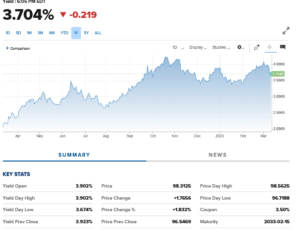
Over 48 hours two banks failed for very different reasons. There is a saying in banking that when rates rise and easy money runs out, we will find the skeletons that have been lurking in plain sight. Are we in for a 2008 rerun? What caused the sudden collapse of these two banks? Is the collapse isolated or is there something else lurking under the surface? Have the regulators been asleep at the wheel? What do the failures mean for real estate?
Silicon Valley Bank (SVB) and Silvergate failed
Although both banks failed within a day or so of each other, fortunately the reasons were not related. They failed for radically different reasons.
Silvergate: They were taking in deposits and investing in cryptocurrencies. As cryptocurrency values fell they didn’t have the liquidity to pay depositors as they withdrew their money. This is reminiscent of the subprime crisis where banks were investing in risky securities. Unfortunately it is even worse for Silvergate as the cryptocurrencies could ultimately have a value of zero.
Silicon Valley Bank: This failure is much more troubling as SVB was not investing in crazy things. SVB, like most banks, they take deposits and then will either lend out the money or invest in US Treasuries. In SVB case they invested in US treasuries which are considered a “safe asset”. Unfortunately SVB made a classic mistake in that their maturities mismatched their deposits.
SVB was buying longer term treasuries. As you can see from the chart above, yields have risen considerably. Remember that as yields rise bond prices fall. For example today, the value of the bond would be $96 dollars (basically a 4% loss if the bond is not kept to maturity). Depending on when SVB bought their bonds, they could be considerably less than that.
To compound matters SVB was very industry specific. As rates have risen, speculative investments in startups has declined, leading many young companies to have cash flow issues/needs. These young companies began withdrawing funds for payroll/operating expenses. The SVB failure was a classic bank run where a few got nervous about SVB and rapidly withdrew their funds while SVB assets had declined due to rising yields and they did not have enough liquidity.
Regulators Asleep at the wheel?
Both failures are classic errors that regulators should have caught. Unfortunately many of the regulators are always focusing on the last crisis as opposed to stopping to evaluate how much the economy has changed. Investing in cryptocurrencies should not have been allowed by an FDIC insured bank as these are not “marketable securities”. Furthermore not catching a mismatch in the maturities of their assets is a classic mistake that was easily preventable. In my first banking class in college we did case studies on bank failures in the 80s due to the same issue. This is an elementary mistake in finance.
After the failures, look for bank regulators to suddenly “wake up” and realize these two failures are just the tip of the iceberg with many more getting ready to drive right off the cliff. The regulators are a day late and a dollar short as the damage is already in the making and likely irreversible as this point in the economy.
Likely many more skeletons waiting to be discovered
Based on these two failures, I expect considerably more “failures” of both banks and other financial institutions in the coming weeks/months. Interest rates are going to keep rising and hold at high levels for a while which will lead to more stress in the economy and on financial institutions. The million-dollar question is who is next.
Furthermore, how the fed handles this failure will dictate what happens. If depositors do not get their funds quickly look for the failures to take off like wildfire.
Exposure to Commercial Loans off the charts
Although we are focusing on elementary mistakes of these two bank failures, there is a much bigger issue looming for financial institutions. Commercial loans are going to be the next shoe to drop that could put the next round of financial institutions under. The market was pricing in rates beginning to decline later this year. Instead rates are still rising and unlikely to fall in 2023 which will lead to a rapid repricing of assets. Take a commercial office building that was worth 20m pre covid. Fast forward a few years with vacancy rising and cap rates taking off from historic lows. That same building might be worth 10m or even less in today’s environment.
We have yet to see a rapid repricing of commercial assets nor do we even know exactly how low they will go. But we do know they will be worth substantially less as leases are not renewed and cap rates are double or triple where they were a year ago. When the regulators wake up there is going to be a blood bath of repricing and huge needs for capital.
What does this mean for real estate lending
On the commercial side, look for continued pullback in getting new deals closed. With cap rates rising, values are not matching rents yet. Look for this trend to continue over the next 18 months or so until there is better alignment between values, cap rates, and rents.
Residential is not totally immune. As banks fail and/or get nervous, underwriting will continue increasing making it harder to get a loan funded. Banks will become even more conservative as the end of this cycle is in sight.
Summary:
As the easy money over the last decade quickly comes to an end, things will begin “breaking” in the economy. The two recent failures are just the beginning and not isolated events. They are indicative of systematic risk in the financial system that has yet to be identified.
Higher rates and in turn recessions are notorious for quickly identifying risk. Unfortunately, real estate will not be immune. Commercial is already starting to swoon and start the party off with the office sector. As rates continue rising and remain higher for longer look for this trend to accelerate and ultimately spill into the residential sector. Look for considerably more spectacular failures in the near term, the only questions are how many and who.
Additional Reading/Resources:
- https://www.wsj.com/articles/where-were-the-regulators-as-svb-crashed-35827e1a?mod=mhp
- https://www.thestreet.com/technology/two-us-banks-collapse-in-48-hours-which-one-is-next
We are a Private/ Hard Money Lender funding in cash!
If you were forwarded this message, please subscribe to our newsletter
I need your help! Don’t worry, I’m not asking you to wire money to your long-lost cousin that is going to give you a million dollars if you just send them your bank account! I do need your help though, please like and share our articles on linkedin, twitter, facebook, and other social media and forward to your friends 😊. I would greatly appreciate it.
Written by Glen Weinberg, COO/ VP Fairview Commercial Lending. Glen has been published as an expert in hard money lending, real estate valuation, financing, and various other real estate topics in Bloomberg, Businessweek ,the Colorado Real Estate Journal, National Association of Realtors Magazine, The Real Deal real estate news, the CO Biz Magazine, The Denver Post, The Scotsman mortgage broker guide, Mortgage Professional America and various other national publications.
Fairview is a hard money lender specializing in private money loans / non-bank real estate loans in Georgia, Colorado, and Florida. We are recognized in the industry as the leader in hard money lending with no upfront fees or any other games. Learn more about Hard Money Lending through our free Hard Money Guide. To get started on a loan all we need is our simple one page application (no upfront fees or other games).
Tags: Hard Money Lender, Private lender, Denver hard money, Georgia hard money, Colorado hard money, Atlanta hard money, Florida hard money, Colorado private lender, Georgia private lender, Private real estate loans, Hard money loans, Private real estate mortgage, Hard money mortgage lender
